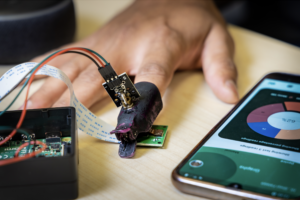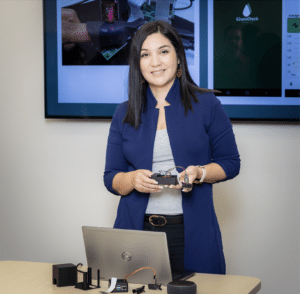By Meghan McCarthy
Editor’s Note: In light of the 2024 PennAITech Symposium, this article is a part of ongoing coverage on the intersection of technology and dementia.
It is estimated that up to 82 percent of people with Alzheimer’s disease (AD) have type 2 diabetes.
The relationship between AD and diabetes is complex. Elevated blood sugar can increase heart disease risk, which may damage blood vessels in the brain. Fluctuating blood sugar and insulin levels may also contribute to cognitive decline. High blood sugar also causes inflammation, which could damage brain cells.
Diabetes often accompanies other AD risk factors, such as a poor diet, smoking history, high blood pressure, and obesity.
Thus, diabetes is a both public health issue and an AD issue.
Researcher Maria Valero de Clemente, PhD, MS, aims to change the landscape of glucose monitoring. Dr. Valero’s own father has diabetes. Motivated by his daily routine of finger-pricking to monitor his blood sugar, Dr. Valero envisioned a noninvasive, eco-friendly, and cost-effective alternative. This quest led her to develop Glucocheck.
Powered by artificial intelligence (AI), Glucocheck analyzes light absorption after shining infrared light onto one side of a finger, with a small camera placed on the opposite side to photograph the absorption. Glucocheck’s AI then assesses the individual’s glucose levels. This noninvasive glucose monitor is also a semi-continuous monitoring system intended for durability with proper care.
“Continuous glucose monitors still use a subcutaneous needle and only last 10-15 days,” Dr. Valero said. “I like them, but you need to replace many aspects of the device. It wastes plastic and can be very expensive, especially for an older population.”
Dr. Valero’s pilot study, funded by the Penn Artificial Intelligence and Technology Collaborating for Healthy Aging (PennAITech), focuses on validating the device’s accuracy across different races and ethnicities.
Preliminary results show Glucocheck’s accuracy is near 90 percent when compared to traditional invasive methods.
Light absorption can be impacted by many factors, including skin pigmentation and humidity level. A primary purpose to Dr. Valero’s study is refining the measurement of glucose levels in individuals with darker skin pigmentation.
Dr. Valero also emphasizes digital accessibility in a mobile app that tracks glucose over time, developed in collaboration with an industrial engineering professor. The app’s design caters to older users with features like larger fonts, clear instructions, and voice assistance.
“We take technology skills for granted,” she said. “Apps aren’t often intuitive enough for older adults to navigate. It’s not that older adults lack capability, but age does affect vision and cognitive perception.”
Beyond the device itself, Dr. Valero is also working on a separate app to promote behavior change techniques through glucose monitoring.
This app allows users to upload meal photos and receive nutrition analysis, followed by tailored exercise suggestions to balance blood sugar levels.
Education and resources to combat diabetes are impacted by social and structural determinants of health, such as socioeconomic status and residence location. For example, incidence of diabetes is especially high in Latino and Hispanic populations.
Originally from Venezuela, Dr. Valero is passionate about creating technology that is accessible to Latino and Hispanic populations.
“Especially in rural areas, people may not have any idea what a Coca Cola does to their body,” Dr. Valero said. “What we want in the end is for people to understand how their diet impacts their glucose levels.”
PennAITech’s support has been crucial, Dr. Valero says, in advancing the project and drawing further interest.
“PennAITech has been fundamental to bringing our project to the next level,” she said. “They were the first ones who actually looked at us and saw the potential. After they funded us, everybody wanted to talk to us. They gave us the push we need, and I’m very grateful for that.”
Dr. Maria Valero is an assistant professor in the College of Computing and Software Engineering, Department of Information Technology at Kennesaw State University (KSU) and Director of IoT as Service Research Group. She received her Ph.D in Electrical and Computer Engineering at University of Georgia in 2019 and Master in Computer Science from University of Los Andes (Venezuela) in 2009. She was an associate professor at the University of Tachira (Venezuela) from 2004 to 2015. Her research interests include IoT for smart healthcare, distributed computing, signal processing, wireless sensor networks, and cyber-physical systems.

